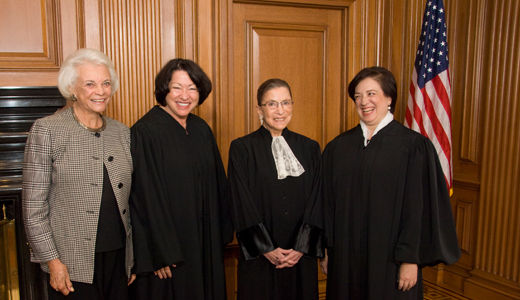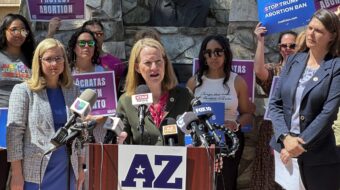
Today marks the 85th birthday of Sandra Day O’Connor or, as she likes to call herself, the FWOTSC, First Woman On The Supreme Court. She was born on March 26, 1930. O’Connor served from her appointment in 1981 by Ronald Reagan until her retirement in 2006. Prior to her appointment to the Court, she was an elected official and judge in Arizona. She was unanimously confirmed by the Senate.
Considered a federalist and a moderate conservative, O’Connor tended to approach each case narrowly without arguing for sweeping precedents. Early in her tenure O’Connor voted with Chief Justice William Rehnquist more than with any other justice. Later on, as the Court’s make-up became more conservative (Anthony Kennedy replacing Lewis Powell, and Clarence Thomas replacing Thurgood Marshall), O’Connor often became the swing vote on the Court. However, she usually disappointed the Court’s more liberal bloc in contentious 5-4 decisions: In her last decade she joined the traditional conservative bloc of Rehnquist, Antonin Scalia, Kennedy and Thomas three times more than she joined the liberal bloc of John Paul Stevens, David Souter, Ruth Bader Ginsburg and Stephen Breyer.
O’Connor’s relatively modest shift away from conservatives on the Court seems to have been due at least in part to Thomas’s views. When Thomas and O’Connor were voting on the same side, she would typically write a separate opinion of her own, refusing to join his.
O’Connor came to the Court with a quiet history of opposing restrictions on abortion, one of the main “hot-button” issues for the right wing. Although not an absolutist on principle, she never voted specifically to outlaw abortion. In Lawrence v. Texas in 2003, O’Connor contended that state laws that prohibited homosexual sodomy, but not heterosexual sodomy, violated the Equal Protection Clause of the 14th Amendment.
Another 2003 case in which O’Connor cast the deciding vote was McConnell v. FEC, which upheld the constitutionality of most of the McCain-Feingold campaign-finance bill regulating “soft money” contributions.
On December 12, 2000, O’Connor joined with four other justices on the Bush v. Gore case that ceased challenges to the results of the November presidential election, thereby stopping the ongoing Florida election recount and effectively ending Al Gore’s hopes to become president. Ralph Nader has called this decision “a judicial coup d’état.” Others have quipped that Bush won that election fairly by a solid majority – 5 to 4 on the Supreme Court! O’Connor has since publicly doubted the wisdom of the Supreme Court taking the case.
In 2003 O’Connor authored a majority opinion in Grutter v. Bollinger, saying racial affirmative action wouldn’t be constitutional permanently, but long enough – approximately 25 years – to correct past discrimination. After retiring she said she believed racial affirmative action should continue to help heal the inequalities created by discrimination, not as a cure-all, but rather a bandage. She added that society has to do much more to correct our racial imbalance.
President George W. Bush nominated Samuel Alito to replace O’Connor; he was sworn in on January 31, 2006.
On January 26, 2010, O’Connor issued her own polite public dissent to the Citizens United v. Federal Election Commission decision on corporate political spending, telling law students that the court has created an unwelcome new path for wealthy interests to exert influence on judicial elections.
Although reviled at the time by most liberals and progressives as a conservative – the only kind of woman Ronald Reagan would have appointed to the Court – in retrospect she was far more balanced than the subsequent crop of justices appointed by Reagan and fellow Republicans G. H. W. Bush and G. W. Bush. The three women presently serving on the Supreme Court were all appointed by Democrats – Ginsburg by Clinton, and Sonia Sotomayor and Elena Kagan by Obama.
On August 12, 2009, President Obama awarded Justice O’Connor the U.S. Presidential Medal of Freedom.
Adapted from Wikipedia.
Photo: The four women who have served on the Supreme Court of the United States. From left to right: Justice Sandra Day O’Connor (Ret.), Justice Sonia Sotomayor, Justice Ruth Bader Ginsburg, and Justice Elena Kagan in the Justices’ Conference Room, prior to Justice Kagan’s Investiture Ceremony on October 1, 2010. Steve Petteway, photographer for the Supreme Court of the United States.












Comments